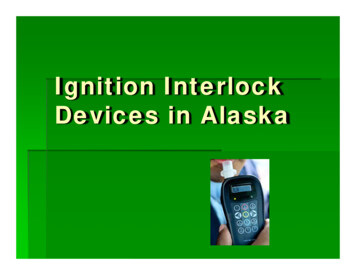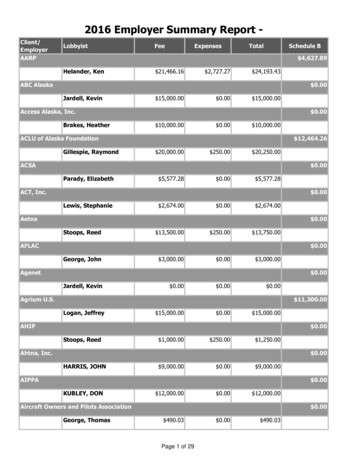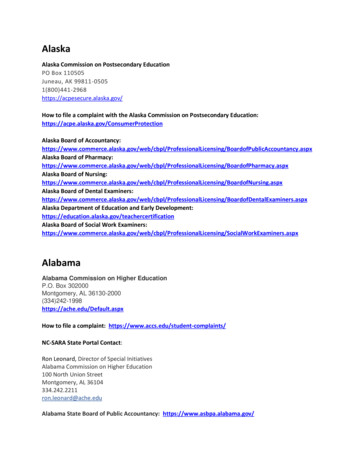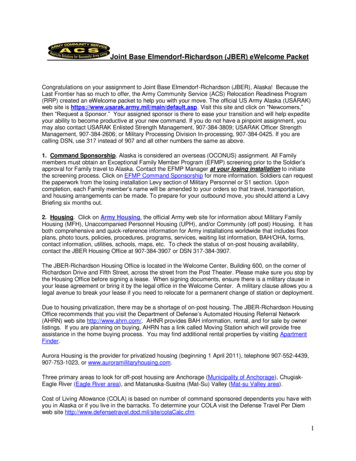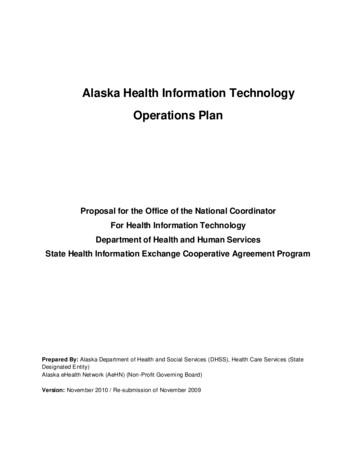
Transcription
Alaska Health Information TechnologyOperations PlanProposal for the Office of the National CoordinatorFor Health Information TechnologyDepartment of Health and Human ServicesState Health Information Exchange Cooperative Agreement ProgramPrepared By: Alaska Department of Health and Social Services (DHSS), Health Care Servic es (StateDesignated E ntity)Alaska eHealth Net work (AeHN) (Non -Profit Governing Board)Version: November 2010 / Re-submission of November 2009
Alaska Health Information Technology Operations PlanNovember 2010Table of Contents12Introduction51.1 Overview5Health Information Technology Planning Schedule72.1 EHR Incentive Program92.1.1 State Level Repository102.2 Meaningful Use Dat a in Year 1112.2.1 Eligible Hospitals122.2.2 Eligible Professionals152.3 Medicaid Management Information System162.4 Master Client Index172.5 Tri State Children's Health Improvement Consortium182.6 Telehealth / Telemedicine192.7 Broadband Expansion202.7.1 FCC Pilot Project202.7.2 TE RRA Project202.8 Workforce Development212.9 Regional Extension Center212.10 Healt h Information Exchange (HIE)222.10.1 HIE Coordination233Health Information Technology Coordination and Collaboration254Other Coordination274.1 Healt h Information Security and Privacy Collaboration274.2 Pacific Nort hwest Health Policy Consortium284.3 Medicaid294.4 Federal Health E ntities294.5 Other A RRA Programs304.6 Federal National Health Information Net work30Alaska Health Information Exchange Operations Plan335.1 Principle Activities and Timeline335.2 Risk Management375.3 AeHN Organizational Structure4055.3.1 Decision Making Authority415.4 Finance435.4.1 Background435.4.2 Financial Model445.4.3 Sustainability44DHSS/HCSPage 2 of 87
Alaska Health Information Technology Operations PlanNovember 20105.4.4 Funding Sources455.5 Technical Infrastructure495.5.1 Technology Overview495.5.2 Standards495.5.3 Certifications505.5.4 Technology Architecture505.5.5 Interoperability515.5.6 Protection of Health Data535.5.7 Training and Support535.6 Business and Technical Operations545.6.1 Preparat ory Activities545.6.2 Key Personnel545.6.3 Planned HIE Capabilities555.6.4 Shared Services and Repositories555.6.5 Outreach and Communications575.6.6 Outreach and Education Tools585.7 Legal and Policy605.7.1 Standardization of Policies and Procedures615.7.2 Privacy615.7.3 Security625.7.4 Participation Agreements62Appendix AKey Personnel CVs and Bios65Appendix BRecord Locator Service (Markle CfH Prototype)72Appendix CAnonymizer and IBM DB2 Analytic s Technology73Appendix DHIE Participation Agreement Template74Appendix EAcronym s85Appendix FEndnote s87DHSS/HCSPage 3 of 87
Alaska Health Information Technology Operations PlanNovember 2010List of Figures and TablesFigure 1 – Health Information Technology Systems Working Together .8Figure 2- HIT Plan .9Figure 3 - EHR Plan .10Figure 4 - State Level Repository .11Figure 5 - Meaningful Use Plan.12Figure 6 – Eligible Hospitals Clinical Quality Measure Capabilities .12Figure 7 – Eligible Professionals Clinical Quality Measure Capabilities .15Figure 8 - MMIS Plan .17Figure 9 - State MCI Plan .17Figure 10 - T-CHIC Plan.18Figure 11 – The Alaska Tribal Health Systems Referral Patterns .19Figure 12 - FCC Pilot Project Plan .20Figure 13 - TE RRA Plan.20Figure 14 - Workforce Development Plan .21Figure 15 - REC Plan .21Figure 16 - HIE Plan .22Figure 17 - NHIN/Connect Implement ation Status .31Figure 18 - NHIN .32Figure 19 - SDE Org Chart .40Figure 20 - AeHN Board of Directors .41Figure 21 - HIE Overview .51Figure 22 - Record Locator Service.72Figure 23 - Anonymizer .73Figure 24- IBM DB2 Analytics .73Table 1Table 2Table 3Table 4Table 5Table 6– Eligible Hospitals Exchange of Health Information .13– Eligible Hospital EHR Functions .14– Eligible Professionals Exchange of Health Information .16- Principal HIE Activities / Responsible Party .33- HIE Risks .38- Financial Model .44DHSS/HCSPage 4 of 87
Alaska Health Information Technology Operations PlanNovember 20101 Introduction1.1 OverviewIn May 2009, the Alaska legislature unanimously passed Senate Bill 133 (SB 133), a bill supporting theimplementation of a statewide Health Information Exchange (HIE) system that is interoperable andcomplaint wit h state and federal specifications and protoc ols for exchanging health records and data.SB133 required the Department of Health and Social Services (DHSS) to establish a HIE with a non-profitgoverning board that represents Alaska's stakeholder communities. In April 2010, DHSS contracted wit hthe Alaska eHealth Network (AeHN) to be the non-profit governing board that will procure and manageAlaska's HIE.In March 2010 in accordance with the American Recovery and Reinvestment Act (ARRA ), the Governornamed DHSS, Division of Health Care Servic es (DHCS ) as the State Designated Entity (SDE) toimplement Alaska's HIE under the Office of the National Coordinator (ONC) Cooperative AgreementProgram. The Governor also announced Mr. Paul Cartland as the State Health Information Technology(HIT) Coordinator.In addition to SB 133, the Alaska Health Care Commission (AHCC) was established in December 2008under Administrative Order 246 (A.O. 246), to address growing concerns over the condition of Alaska'shealthcare system. In January 2010 the A HCC, in accordance with A.O. 246, provided a five year (2010– 2014) strategic plan on transforming health-care in Alaska. The AHCC was chartered to providerecommendations to the governor and the state legislature for the development of a statewide plan toaddress quality, accessibility and availability of health care for all citizens of the state. The Commissionenvisions a healthcare system for Alaska that places individual Alaskans and their families at the centerof their healthcare experience and focuses on creating health, not simply treating illness and injury.The HIT Governanc e Committee was established in April 2010 to coordinate statewide health informationtechnology efforts and to provide vision and oversight for all HIT programs in which DHSS participates.The committee addresses State project management and task responsibilities for successfulcoordination. DHSS has been in coordination with AeHN, who will procure and manage Alaska’s HIE. Inaddition to being the non-profit governing board that will procure and manage Alaska's HIE, AeHNreceived funding in April 2010 from the A RRA to establish one of 60 nationwide HIT Regional ExtensionCent ers (RE C).The SDE recognizes that it plays a significant role in trans forming healthcare in Alaska. In developing itsvision for HIT for the future, the SDE has aligned its goals with that of the AHCC and the HIT GovernanceCommittee. The AHCC believes that access to good healthc are, both physical and mental, is essential toall Alaskan’s ability to actively participate in and cont ribut e to their families, schools, places ofemployment, and communities. The HIT governance committee supports implementation of HIT projectsto improve affordability, accessibility, quality of health care, and improved healt h status of Alaskans.SDE is promoting HIT development through support or implementation of the Health InformationExchange Cooperative Agreement Program, EHR inc entive program, Children's Health InsuranceProgram Reauthorization Act (CHIP RA) Quality Initiative, Multi-state HIT Coordination and ARRAcoordination.The SDE vision for HIT in the future is a multi-year vision and consists of existing and planned projectsand initiatives that will significantly contribute to Alaska’s healthcare transformation. SDE is workingDHSS/HCSPage 5 of 87
Alaska Health Information Technology Operations PlanNovember 2010towards improving and updating various state systems that will increase the use for HIT, includingVacTrAK, Master Client Index, Electronic Vital Records System (EVRS) and the Lab InformationManagement Systems (LIMS). By leveraging implementation of new technologies such as a modernizedMedicaid Management Information System (MMIS), that extends web based access to providers andmembers, Electronic Health Records (EHR), and HIE networks, the SDE will do its part in supporting ahealthcare system for Alaska that places individual Alaskans, their families and communities at the centerof their healthcare experience and ultimately shift the focus from treatment to prevention and to increasemeaningful use of E HRs.Telehealth systems, such as teleradiology, telebehavioral health, telepharmacy, and distance learningsystems utilizing videoconferencing equipment are also emerging as cost-effective ways to improvehealthcare quality outcomes. Interoperable HIT systems built with these fundamental components can beutilized to enhance patient safety and continuity of care by streamlining access to critical healthcareinformation by both clinicians and cons umers alike. Through broadband initiatives, the use of telehealthservices could greatly improve the accessibility and improved health status for Alaskans.The operations plan outlines the initial strategy that the S DE has established to implement a statewideHIE and to promote the use of HIT to improve the healthc are for Alaskans. The operations plan willoutline how the SDE, State HIT Coordinat or, HIT Governance Committee, AeHN, HIE Board and keyhealthcare stakeholders will work toget her to ensure the success of implementing a statewide HIE andpromotion of HIT.DHSS/HCSPage 6 of 87
Alaska Health Information Technology Operations PlanNovember 20102 Health Information Technology Planning ScheduleLike many states, healthcare in Alaska is at a cross roads. After many years of independentdevelopment around siloed programs and funding streams, delivery of care has bec ome moreand more fragmented resulting in increasing costs, barriers to health care and decreasing qualityoutcomes of health care services provided.Healt h Information Technology (HIT) efforts offer great promise as a means to achieve more affordable,safe, and accessible healthcare for Alaskans statewide. Integrated HIT has the ability to bring all levels ofmedical care together, from general practitioners to specialists, effectively bridging the healthcare gapexperienced by many of our communities where shortages of appropriat ely trained healthcare providershave been difficult to resolve.Improving healthcare for all Alaskans through the use of HIT is foundational in the vision and priority toAlaska’s leaders hip to increase healthcare efficiencies and effectiveness and improving clinical qualityand patient safety. Successful implementation of HIT, encompasses many proc esses that will have towork together to ensure the exchange of health information provides the res ults that are needed toimprove the health of Alaskans.Integration of HIT applications will improve quality of care for Alaskans including increased patient safety,enhanced provider to provider sharing of relevant patient information, improved continuity of care,improved access to essential services in underserved areas, simplification of patient education, anddecreased costs related to improved efficiencies in management of clinical data and treatment relatedinformation. HIT will improve the overall healt h of the state’s population by forging a cost -effectivepartnership bet ween these key stakeholders – patients, individual practitioners, provider / payerorganizations and employers / Alaska businesses.The expected outcomes of HIT utilization and having a fully implemented Alaska Health InformationExchange (HIE) with connectivity to state systems, public health Electronic Health Records (EHR),laboratories, electronic medical rec ords (EMR), e-prescribing, personal health records, will be improvingpatient access to medical care, improve patient safety, reduc e unnecessary testing and procedures,reduce health agency administrative costs, and enhance rapid response to public health emergencies.DHSS/HCSPage 7 of 87
Alaska Health Information Technology Operations PlanNovember 2010Figure 1 – Health Information Technology System s Working TogetherThe State Designat ed Entity (SDE) will seek leadership from the Office of the National Coordinator (ONC)for the successful implementation of statewide HIT activities. The state has entered into severalagreements with the Center for Medicare and Medicaid Services (CMS) and ONC for HIT that require thestate to coordinate HIT efforts. The HIT activities are all interdependent; in order for this plan to besuccessful the statewide HIT plan is reliant on the deployment of Alaska’s HIE, implementation of theState Medicaid Healt h Information Technology Plan (SMHP) and the ot her American Recovery andReinvestment Act (ARRA) HIT initiatives. The State rec ognizes that the HIE will not be effective withoutthe connection of certified EHRs or other databases. The provider adoption of certified EHR will move thestate forward in meeting meaningful us e standards.The SDE is in collaboration with Alaska eHealth Network (AeHN), Alaska Electronic Healt h RecordAlliance (AEHRA), and with ot her divisions within the Department of Health and Social Services ( DHSS)to successfully implement the HIE Cooperative Agreement. Additionally , the SDE is collaborating withother units within Division of Health Care Services (DHCS) for successful implementation of other statedriven HIT initiatives including the EHR Inc entive Program and the Children's Health Ins urance ProgramReauthorization Act (CHIPRA) quality initiative in addition to building the new MMIS system andincreasing connectivity to the state Master Client Index (MCI). There are other HIT initiatives that arebeing implemented in Alaska including the Terrestrial for E very Region of Rural Alaska (TE RRA) project,Federal Communications Commission (FCC) Rural Health Pilot Program, workforce development, thatare all working together to exchange health information. The availability of broadband in those regionscould greatly impact the health of Alaskans to provide increasing availability of healt h information to ruralcommunities.This section includes an overview of how the SDE will move the current HIT environment to achieve thevision for HIE.DHSS/HCSPage 8 of 87
Alaska Health Information Technology Operations PlanNovember 2010Figure 2- HIT Plan2.1 EHR Incentive ProgramThe EHR Incentive Program activities began in January 2010 wit h the CMS Planning Advanced PlanningDocument (PAPD) and will continue through final provider payments in 2021. The implementation of theprogram will serve as a catalyst for additional Alaska medical providers to join the state-wide HIE as it isimplemented. Given the ever-rising cost of healthcare in Alaska, the goal is to make improvements in costefficiencies and outcomes to reduce the costs of the Medicaid program and improve the quality of healthcare for patients.SDE plans to enhance the current Provider Enrollment Portal (PEP) to include a State Level Repository(SLR) that will provide a web-based state attestation and tracking system to capture, calculate and storepatient volume and payment calculations, and collect required meaningful use data and reporting. TheSLR module is currently under development for multiple states to support the EHR Incentive program.SDE expects to implement the SLR wit h minimal changes to leverage the solution in Alaska. SDE doesnot intend to make system modifications to the existing Legacy Medicaid Management InformationSystem (MMIS). The S DE will assess the need to develop additional interface requirements for the newMMIS, Alaska Medicaid Health Enterprise, post-implementation to support the SLR in a more aut omatedand integrated manner.The Alaska SLR design and implementation will be broken into two distinct phases to meet federaltimelines. The Alaska SLR will be in place in January 2011 with payments beginning in April 2011. Phase1 will include eligibility calculations and attestation capabilities and will focus on Group 1 National LevelRepository (NLR) testing, SLR configuration, testing, outreac h, training and implementation. Phase 2 willexecute the payment cycle and will focus on payment configuration, testing and implement ation.DHSS/HCSPage 9 of 87
Alaska Health Information Technology Operations PlanNovember 2010Figure 3 - EHR PlanSDE expects to manage the EHR Incentive Payment Program using res ources located in the HITProgram Office within DHCS. This office will support the review and approval of Provider IncentiveProgram requests received from the NLR, monthly payment processing and required EHR IncentivePayment reporting. The Office will leverage existing DHCS Medicaid business processes to manage theprogram such as provider enrollment, provider payment process, provider audits and state and federalreporting.The AKSAS financial system will support the submission and distribution of incentive payments; alongwith the supporting financial reports. The standard Direct Connect soft ware product will be used toexchange NLR information with CMS.2.1.1 State Level RepositoryThe web-bas ed state attestation and tracking solution, Alaska SLR, will support the requirements formeaningful use and incentive payments mandated by the A RRA Health Information Technology forEconomic and Clinical Healt h (HITE CH) Act. The Alaska SLR will allow the state to interact with the NLR,providers, and integrate wit h other State systems like MMIS, in order to deliver comprehensive datasupport for the provider incentive payment program.Phase 1 SLR features include:Secure log-in,Self-s ervice review and edit of provider demographic information,Role-based screens for providers (EP or EH) and state staff,Facilitation of provider registration and attestation - adoption / implementation / upgrade ormeaningful use,Submission of complet ed forms to State Medicaid entities ,Messaging to providers from State Medicaid entities,Routing and approval of provider registration information, andOn-line help and user manual.DHSS/HCSPage 10 of 87
Alaska Health Information Technology Operations PlanNovember 2010Phase 2 SLR features include:Payment calculation function,Initiation of the payment cycle,Payment history log,Initiation of a provider appeal,Management of appeals,Upload meaningful use quality metrics in approved XML format, andReview and reporting of quality metrics.Figure 4 - State Level Repository2.2 Meaningful Use Data in Year 1The implementation of the HIE in Alaska will provide an important vehicle to facilitate the standardization,exchange and outcome focus on the EHR dat a. In addition, the planned improvements in the AlaskaMedicaid Data Warehouse will allow DHCS to consolidate and evaluate appropriate meaningful us e datain the coming years.In 2011, year one meaningful use data will be captured, and evaluated for the purposes of the providersmeeting the eligibility requirements to attest to the ability to manage meaningful use data. The currentplan is to collect the data elements and quality measures using the Alaska SLR that will be implementedto support the EHR Incentive Payment program.The HIE, once it is operational and has been connected to the certified EHR’s, will have the capabilit y tocollect clinical quality measures that support meaningful use. The plans for implementation of the HIEinclude a pilot project that will connect 2 large facilities and 20 providers to the HIE between FebruaryDHSS/HCSPage 11 of 87
Alaska Health Information Technology Operations PlanNovember 2010and June 2011. In summer and fall 2011 the remainder of the providers will be able to connect with theHIE. This will provide the opportunity for providers to start the submission of clinical quality measuresthrough the HIE. For the first phase of implementing the HIE, it will have the capabilities to accept andsend electronic prescriptions, structured lab results and transmission and receipt of patient care summaryrecords.The SDE plans to identify an appropriate technical solution that is in alignment with the new MMIS andthe Alaska HIE that supports the electronic collection of clinical quality measures. By January of 2012,DHCS expects to have the MMIS solution in place to support providers that will be in a position todemonstrate Meaningful Us e of their EHR systems.Figure 5 - Meaningful Use Plan2.2.1 Eligible HospitalsThe below pie charts outline the current clinical quality measure capabilities and awareness of hos pitalsfor Electronic Prescribing (e-prescribing), receipt of structured lab results and patient care summary ofcare records.Figure 6 – Eligible Hospital s Clinical Quality Measure CapabilitiesClinical Lab TestResultsSummary ofCareElectronicPrescribing% in Use% in Use% in Use% Not in use% Not in use% Not in use% Not Functionally available% Not Functionally available% Not Functionally available% No response or not sure% No response or not sure% No response or not sure8%8%17%17%92%25%33%33%33%34%The providers who participated in the SDE sur vey were asked:Are you recording clinical lab test results as structured data?Are you using a feature that allows transmission and receipt of summar y care recor ds fortransitions of care and referrals?Are you using electronic prescribing?DHSS/HCSPage 12 of 87
Alaska Health Information Technology Operations PlanNovember 2010There were a total of 16 unduplicated hospitals that participated in either the first or second survey. Ofthe 16 unique hospitals, there were a total of 12 hospitals that indicated that they had an EHR. Of the 12hospitals:92% indicated that they record structured clinical lab test results,33% are using a feature that allows transmission and rec eipt of summary of care records, and25% are using electronic prescribing.Additionally in the survey, hospitals were asked to indicate with which entities they were sharing healthinformation electronically using their EHR. Of the 12 hospitals that indicated that they had an EHR, thebelow chart indicates the number of hospitals sharing health information wit h other entities.Table 1 – Eligible Hospital s Exchange of Health Information# of hospital s currently sharing health informationelectronically with entities using EHRNone1Hospital(s)3Laboratory(s)6Other provider(s)10Pharmacy(s)6Others1% ofHospital s8.3%25.0%50.0%83.3%50.0%8.3%The clinical lab test results indicate that many of the organizations record clinical lab tests results, andthat 50% of the hospitals are sharing health information with other laboratories. All of the hospitalsindicated that they would be int erested in participating in the EHR incentive program, which will requirethat they upgrade to a certified EHR and meet stage 1 meaningful use. The HIE will have the capabilitiesto exchange the structured labs at initial implementation.33% of hospitals are currently using the feature that allows transmission and receipt of summary of carerecords, additionally 33% of the hospitals do not use that feature of their EHR, and 17% either do nothave that feature or the participant did not respond or was not sure of their currently capabilities. Theresults of the survey convey that hospital staff will need to be educated on understanding what theircurrent EHR capabilities include. AeHN through the REC will be able to do on site technical assistance,education and out reach. Additionally SDE will provide onsite presentations and education, send out flyersand letters to organizations to increase knowledge of the EHR meaningful use requirements and ensuringthat the feature is being used to meet the meaningful use.As indicated by the hospitals all of them plan on participating in the EHR incentive program, of thosehospitals 8 of them planned on enrolling in the program by 2011, 3 planned on enrolling in 2012, 1indicated they would enroll in 2013 and 4 did not respond to the time frame they would enroll in theprogram. For the hospitals that qualify to participate in the E HR incentive program, this will address theircurrent EHR functionality and they will be required to use that function to meet meaningful userequirements. For the organizations who are currently sharing s ummary of care information acrossentities, once the HIE is implemented this will increase of rec eipt and transmission of summary carerecords between entities and will allow a great er capability to exchange with a broader range of entitieswho are participating in the HIE.Of the hospitals surveyed with an E HR, 25% are using electronic prescriptions, 34% of the hospitalsindicated that they do not use that feat ure, and 33% of the hospital E HR’s do not have that function.DHSS/HCSPage 13 of 87
Alaska Health Information Technology Operations PlanNovember 2010Additionally 50% of the hospitals indicated that they share health information with pharmacies. Based onthe other responses in the survey the hospital EHR’s have additional functionalities which would allow theexchange of health information with pharmacies.Table 2 – Eligible Hospital EHR FunctionsHospital s EHR Medication FunctionsAre you using drug-drug interaction checks?Are you using drug-allergy checks?Are you using drug-formulary checks?Are you using patient medication lists?Are you using patient medication allergy lists?Are you using medication reconciliation?# ofHospital s101099117% ofHospital s83.3%83.3%75.0%75.0%91.7%58.3%In order to meet meaningful use criteria the state is working to implement a standalone solution that willbe available to providers regardless of their EHR implement ation status in addition to the functionalityprovided by the HIE. The SDE is currently working on a plan to address the gaps in e -prescribing.Additionally, HIE will have e-prescribing capabilities and will also be able to rec eive electronicprescriptions from hospital or practice EMRs.Of the 16 hos pitals surveyed, 9 indicat ed that they had a wired broadband connection, 4 indicated thatthey had T-1 or T-3 lines and 3 indicated that they have satellite connection. Many of the ruralcommunities do not have adequate internet connection. There are ot her state initiatives that areaddressing broadband access to the rural communities to ens ure that they have adequate access to theinternet.DHSS/HCSPage 14 of 87
Alaska Health Information Technology Operations PlanNovember 20102.2.2 Eligible ProfessionalsThe pie charts below outline the current clinical quality measure capabilities and awareness of eligibleprofessionals for e-prescribing, receipt of structured lab res ults and patient care summary of carerecords. The provider types that participat ed in this survey will be categorized as eligible professionals,although it is understood that not all provider types will be eligible to participate in the EHR incentiveprogram.Figure 7 – Eligible Professionals Clinical Quality Measure CapabilitiesClinical Lab TestResultsSummary ofCareElectronicPrescribing% In Use% In Use% In Use% Not In Use% Not In Use% Not In Use% Not Functionally available% Not Functionally available% Not Functionally available% No response or not sure3% 2%% No response or not sure% No response or not sure1%95%12% 3%84%
Alaska Health Information Technology Operations Plan November 2010 DHSS/HCS Page 2 of 87 Table of Contents 1 Introduction 5 1.1 Overview 5 2 Health Information Technology Planning Schedule 7 2.1 EHR Incentive Program 9 2.1.1 State Level Repository 10 2.2 Meaningful Use Data in Year 1 11
